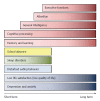Short and long term neuro-behavioral alterations in type 1 diabetes mellitus pediatric population
- PMID: 25789107
- PMCID: PMC4360419
- DOI: 10.4239/wjd.v6.i2.259
Short and long term neuro-behavioral alterations in type 1 diabetes mellitus pediatric population
Abstract
Type 1 diabetes mellitus (T1DM) is one of the most prevalent chronic conditions affecting individuals under the age of 18 years, with increasing incidence worldwide, especially among very young age groups, younger than 5. There is still no cure for the disease, and therapeutic goals and guidelines are a challenge. Currently, despite T1DM intensive management and technological interventions in therapy, the majority of pediatric patients do not achieve glycemic control goals. This leads to a potential prognosis of long term diabetic complications, nephrological, cardiac, ophthalmological and neurological. Unfortunately, the neurological manifestations, including neurocognitive and behavioral complications, may present soon after disease onset, during childhood and adolescence. These manifestations may be prominent, but at times subtle, thus they are often not reported by patients or physicians as related to the diabetes. Furthermore, the metabolic mechanism for such manifestations has been inconsistent and difficult to interpret in practical clinical care, as reported in several reviews on the topic of brain and T1DM. However, new technological methods for brain assessment, as well as the introduction of continuous glucose monitoring, provide new insights and information regarding brain related manifestations and glycemic variability and control parameters, which may impact the clinical care of children and youth with T1DM. This paper provides a comprehensive review of the most recently reported behavioral, cognitive domains, sleep related, electrophysiological, and structural alterations in children and adolescences from a novel point of view. The review focuses on reported impairments based on duration of T1DM, its timeline, and modifiable disease related risk parameters. These findings are not without controversy, and limitations of data are presented in addition to recommendations for future research direction.
Keywords: Adolescences; Alterations; Behavioral; Brain; Children; Cognitive; Type 1 diabetes mellitus.
Figures


References
-
- Miles R, Root F. Psychologic tests applied to diabetic patients. Arch Intern Med. 1922;30:767–777.
-
- Biessels GJ, Deary IJ, Ryan CM. Cognition and diabetes: a lifespan perspective. Lancet Neurol. 2008;7:184–190. - PubMed
Publication types
LinkOut - more resources
Full Text Sources
Other Literature Sources
Medical

